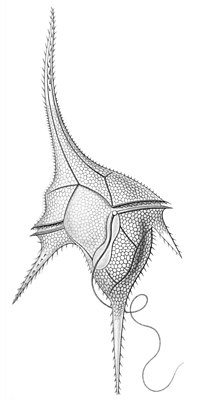Ceratium hirundinella
| Ceratium hirundinella | ||||||||||||
|---|---|---|---|---|---|---|---|---|---|---|---|---|

Ceratium hirundinella |
||||||||||||
| Systematics | ||||||||||||
|
||||||||||||
| Scientific name | ||||||||||||
| Ceratium hirundinella | ||||||||||||
| ( OV Müller ) Bergh |
Ceratium hirundinella is a type of dinoflagellate . The unicellular alga feeds through photosynthesis and is found in both salt and freshwater habitats.
description
The cells are dark brown and have a central groove. They are 80 to 400 micrometers long and severely flattened. The outermost horn is long and narrow, with a blunt end, the two horns on the opposite side are straight with pointed ends and usually point in slightly different directions; there may be a third horn on this side. The cells can form short chains and have a high salt tolerance. They move in a rotating manner.
ecology
The species feeds through photosynthesis, and mixotrophy also occurs. It is common in lakes of temperate latitudes, where it represents a significant proportion of phytoplankton seasonally . The density of the stocks is highest in August / September, at this time it can form almost monospecific stocks. This phase ends suddenly, as the cells turn into immobile, thick-walled cysts in autumn, which sink into the sediment and hibernate there and only excystate again in spring or early summer. Occasionally, however, only a few of the cells encyst at the end of the season, which then leads to mass death. The species mainly occurs near the surface; its mobility enables it to actively influence its horizontal position in the water and thus prevent it from sinking into the sediment.
The cysts can be parasitized by a potty fungus. Another type of potty mushroom is a saprophyte on vegetative cells, but fungi that parasitize at this stage are absent.
Individual evidence
- ↑ a b c d p. I. Heaney, JF Talling: Ceratium hirundinella - ecology of a complex, mobile, and successful plant. In: Forty-eighth annual report for the year ended March 31st 1980, Freshwater Biological Association, Ambleside (UK), 1980, pp. 27-40.
- ↑ Ceratium hirundinella in the Encyclopedia of Life . Retrieved August 17, 2011.
- ^ G. Smalley, D. Coats: Ecology of the Red-Tide Dinoflagellate Ceratium furca : Distribution, Mixotrophy, and Grazing Impact on Ciliate Populations of Chesapeake Bay